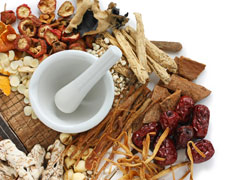
Acupuncture is just one element, explore some of the others
Traditional Chinese Medicine (TCM) includes several techniques that work to heal your body naturally. TCM treatments are cumulative and the effects grow over time if you are consistent in your care.
Perhaps you’ve heard of acupuncture, which is one of the more comment components within TCM. However, there are several others that might be used—especially in tandem with acupuncture treatment, or other wellbeing treatments such as massage or exercise.
To help navigate the world of TCM, the George Wellbeing Center, outlines some of the most popular elements you might encounter:
Herbal medicine
Herbal medicine is very commonly used with acupuncture as part of a treatment plan. Using herbs is like having a daily “treatment” between trips to see an acupuncturist. Herbal medicine can safely treat anything from the common cold or sprained muscle, to complex and chronic diseases.
There are hundreds of TCM herbs, often different parts of plants—root, branch or flower. Animal products like shells or insects are used on occasion. Some foods and spices are also used, including ginger and scallion. Like a well-formulated recipe, Chinese herbal formulas use anywhere from one to more than a dozen herbs.
Cupping
Cupping includes applying glass, silicone or bamboo cups to the surface of the body. Cups are placed upside-down and adhered to specific areas of skin using an air vacuum. Cups might be left on for a few minutes, quickly removed, or slid around an affected area.
Almost like a massage in reverse, this type of therapy can help many issues, including chronic pain, common colds and sore muscles by pulling up tissue to aid in releasing it.
Gua sha
Gua sha is a healing skin technique that includes rubbing a tool over an area—usually the back, neck, arms, legs or face—using massage oil for comfort. This therapy can help reduce inflammation, muscle tightness/pain and fever, while increasing healthy blood circulation in the area. Research has also shown that gua sha increases immune system function, and reduces internal organ inflammation to reduce symptoms of issues like asthma and liver disease.
Tui na
The Chinese system of massage, known as tui na, uses unique hand movements and feels quite different from deep-tissue, gentle relaxation or spa-type massage. It’s based on Chinese medical theory related to acupuncture points and energy pathways with the goal of treating specific disorders, or helping to reduce stress and muscle tension.
Tai chi/qi and qigong
Qi (or chi) is the animating power that permeates the universe and all living things. It is a basis for TCM and flows throughout the body’s energy pathways to help maintain essential health.
Tai chi and qigong are movement exercises to help build qi by focusing on proper breathing techniques and meditation. Both are healing arts that originated in China thousands of years ago. The art of Qigong can be practiced as physical movement that incorporates breathing exercises, or as stationary meditation. Tai Chi is a series of continuous, circular, slow, relaxed and smooth flowing movements.
Moxibustion
Moxibustion (or moxa) is a type of heat therapy. It typically uses the herb mugwort, and is burnt near or on the skin, often using protective cream.
Moxibustion warms the body and moves areas of congestion, helping to reduce symptoms related to many conditions, including pain and digestive complaints, excessive menstrual bleeding, allergy symptoms. Moxa can also increase immunity and even help with a breech presentation during pregnancy.
Ready to get started with TCM?
The George Wellbeing Center at the Dayton Y in downtown Minneapolis offers a variety of TCM services.
Your first foundational session is a private 90-minute appointment that includes an intake (discuss medical history, health concerns and wellbeing goals), physical exam (assessing the tongue, pulse and physical palpation of the body), differential diagnosis (rule out what’s NOT going on, identify gaps in care that need to be addressed), acupuncture treatment and recommendations on additional elements of TCM that might be helpful for continued care.
During your visit, you might also ask questions like, “What can I do once I leave your office to contribute to my health?” and “How can you help me reach my health and wellbeing goals?”